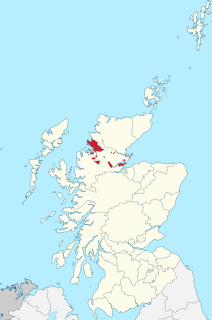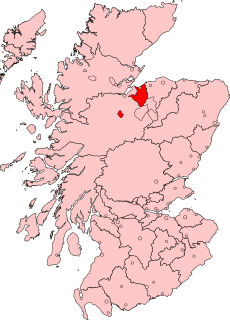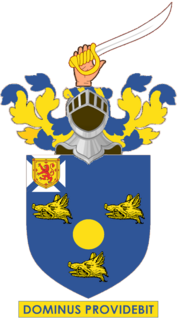Related Research Articles

Cromarty is a town, civil parish and former royal burgh in Ross and Cromarty, in the Highland area of Scotland. Situated at the tip of the Black Isle on the southern shore of the mouth of Cromarty Firth, it is 5 miles (8 km) seaward from Invergordon on the opposite coast. In the 2001 census, it had a population of 719.

Cromartyshire is a historic county in the Highlands of Scotland, comprising the medieval "old shire" around the county town of Cromarty and 22 enclaves and exclaves transferred from Ross-shire in the late 17th century. The largest part, six times the size of the old shire, is Coigach, northwest from Ullapool. In 1890, Cromartyshire was merged with Ross-shire into the administrative county of Ross and Cromarty. In 1975, the resulting county was combined with Caithness, Inverness-shire, Nairnshire, Sutherland, and parts of Argyllshire and Morayshire to form the Highland council area.
Anstruther Burghs was a district of burghs constituency of the House of Commons of the Parliament of Great Britain from 1708 to 1800 and of the House of Commons of the Parliament of the United Kingdom from 1801 to 1832.
Sutherland was a Scottish constituency of the House of Commons of the Parliament of Great Britain from 1708 to 1801 and of the Parliament of the United Kingdom from 1801 to 1918.

Ross-shire was a Scottish county constituency of the House of Commons of the Parliament of Great Britain from 1708 to 1801 and of the Parliament of the United Kingdom from 1801 to 1832.
Peeblesshire was a Scottish county constituency of the House of Commons of the Parliament of the United Kingdom (Westminster) from 1708 until 1868. It elected one Member of Parliament (MP) by the first past the post voting system.
Inverness Burghs was a district of burghs constituency of the House of Commons of the Parliament of Great Britain from 1708 to 1801 and of the Parliament of the United Kingdom from 1801 to 1918. It elected one Member of Parliament (MP).
Inverness-shire was a county constituency of the House of Commons of the Parliament of Great Britain from 1708 to 1801 and of the Parliament of the United Kingdom from 1801 until 1918.

Nairnshire was a county constituency of the House of Commons of Great Britain from 1708 until 1800, and of the House of Commons of the United Kingdom from 1801 to 1832.
Tain Burghs, was a constituency of the House of Commons of the Parliament of Great Britain from 1708 to 1801 and of the Parliament of the United Kingdom from 1801 to 1832, sometimes known as Northern Burghs. It was represented by one Member of Parliament (MP).
Wigtownshire, was a Scottish constituency of the House of Commons of the Parliament of Great Britain from 1708 to 1801 and of the Parliament of the United Kingdom from 1801 to 1918. It was represented by one Member of Parliament.
Aberdeen Burghs was a district of burghs constituency which was represented from 1708 to 1800 in the House of Commons of the Parliament of Great Britain, and from 1801 to 1832 in the House of Commons of the Parliament of the United Kingdom.
Amersham, often spelt as Agmondesham, was a constituency of the House of Commons of England until 1707, then in the House of Commons of Great Britain from 1707 to 1800 and finally in the House of Commons of the United Kingdom from 1801 to 1832. It was represented by two Members of Parliament (MPs), elected by the bloc-vote system.
Roderick Macleod 4th of Cadboll was a Scottish Whig politician.
Robert Bruce Aeneas Macleod, 3rd Macleod of Cadboll, was Lord Lieutenant of Cromarty from 1794 until 1833, and, a staunch Tory, he sat as the Member of Parliament (M.P.) for Cromartyshire from 1807 to 1812.
Kinross-shire was a county constituency of the House of Commons of Great Britain from 1708 until 1800, and of the House of Commons of the United Kingdom from 1801 to 1832.
Clackmannanshire was a county constituency of the House of Commons of Great Britain from 1708 until 1800, and of the House of Commons of the United Kingdom from 1801 to 1832.
Before the Act of Union 1707, the barons of the shire of Cromarty elected commissioners to represent them in the unicameral Parliament of Scotland and in the Convention of Estates. After 1708, Cromartyshire and Nairnshire alternated in returning one member to the House of Commons of Great Britain and later to the House of Commons of the United Kingdom.

Sir William Gordon, 1st Baronet was a Scottish politician who sat in the House of Commons between 1708 and 1742.
Sir George Mackenzie, 4th Baronet, of Cromarty and Grandvale, was a Scottish politician who sat in the British House of Commons from 1729 to 1734.
References
- ↑ "Cromartyshire". History of Parliament Online (1690-1715). Retrieved 27 March 2019.
- ↑ "Cromartyshire". History of Parliament Online (1715-1754). Retrieved 27 March 2019.
- ↑ "Cromartyshire". History of Parliament Online (1754-1790). Retrieved 27 March 2019.
- ↑ "Cromartyshire". History of Parliament Online (1790-1820). Retrieved 27 March 2019.
- ↑ "Cromartyshire". History of Parliament Online (1820-1832). Retrieved 27 March 2019.
- ↑ D. W. Hayton, Cromartyshire in The History of Parliament: the House of Commons 1690-1715 (2002).
- ↑ D. W. Hayton, MACKENZIE, Hon. Sir Kenneth, 3rd Bt. (c.1658-1728), of Cromarty. in The History of Parliament: the House of Commons 1690-1715 (2002).
- 1 2 3 4 5 J. M. Simpson, Cromartyshire in The History of Parliament: the House of Commons 1715-1754 (1970).
- ↑ Paula Watson, URQUHART, Alexander (d.1727), of Newhall, Ross. in The History of Parliament: the House of Commons 1715-1754 (1970).
- ↑ Paula Watson, MACKENZIE, Hon. Sir Kenneth, 3rd Bt. (c.1658-1728), of Cromarty and Grandvale. in The History of Parliament: the House of Commons 1715-1754 (1970).
- ↑ Paula Watson, MACKENZIE, Sir George, 4th Bt. (c.1702-48), of Cromarty and Grandvale. in The History of Parliament: the House of Commons 1715-1754 (1970).
- ↑ Eveline Cruickshanks, GORDON, Sir William, 1st Bt. (d.1742), of Invergordon, Cromarty, and Dalpholly, Sutherland. in The History of Parliament: the House of Commons 1715-1754 (1970).
- ↑ Edith, Lady Haden-Guest, GORDON, Sir John, 2nd Bt. (c.1707-83), of Invergordon, Cromarty. in The History of Parliament: the House of Commons 1715-1754 (1970).
- 1 2 3 J. A. Cannon, Cromartyshire in The History of Parliament: the House of Commons 1754-1790 (1964).
- ↑ Edith, Lady Haden-Guest, GORDON, Sir John, 2nd Bt. (?1707-83), of Invergordon, Cromarty. in The History of Parliament: the House of Commons 1754-1790 (1964).
- ↑ Mary M. Drummond, PULTENEY, William (1729-1805), of Westerhall, Dumfries. in The History of Parliament: the House of Commons 1754-1790 (1964).
- ↑ Edith, Lady Haden-Guest, ROSS, George (1700-86), of Cromarty in The History of Parliament: the House of Commons 1754-1790 (1964).
- 1 2 3 4 David R. Fisher, Cromartyshire in The History of Parliament: the House of Commons 1790-1820 (1986).
- ↑ David R. Fisher, DAVIDSON, Duncan (1733-99), of Tulloch, Ross and Myles's, Ongar, Essex. in The History of Parliament: the House of Commons 1790-1820 (1986).
- ↑ David R. Fisher, MACKENZIE (afterwards MACKENZIE FRASER), Alexander (?1758-1809), of Inverallochy, Aberdeen. in The History of Parliament: the House of Commons 1790-1820 (1986).
- ↑ David R. Fisher, MACLEOD, Robert Bruce Aeneas (1764-1844), of Cadboll, Cromarty. in The History of Parliament: the House of Commons 1790-1820 (1986).
- ↑ David R. Fisher, MACLEOD, Roderick (1786-1853), of Cadboll, Cromarty. in The History of Parliament: the House of Commons 1790-1820 (1986).
- 1 2 David R. Fisher, Cromartyshire in The History of Parliament: the House of Commons 1820-1832 (2009).
- 1 2 David R. Fisher, DAVIDSON, Duncan (?1800-1881), of Tulloch Castle, Dingwall, Ross. in The History of Parliament: the House of Commons 1820-1832 (2009).